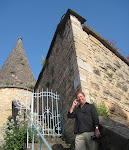
Loretta, Kathy, Holly and I went off the other evening to Trinity Buoy Wharf, on the banks of the Thames river near Canary Wharf opposite the Millennium Dome. It is the site of London's only lighthouse and although no longer functioning, it is home to a very cool artist’s colony. The lighthouse was used for training prospective lighthouse keepers and it was here that Michael Faraday carried out experiments on electromagnetism and electrochemistry. Refurbished shipping containers are used on the present grounds for work and exhibition space. Our mosaic instructor Norma Vondee has a st
 udio here. TBW was hosting an Open Studio night and Les Girls decided to go along and see Norma and participate in her mosaic happening! I particularly enjoyed the work of Dianne Davies who did some really lovely printed textiles of birds. Gillian Burrows showed some interesting Canary Wharf paintings with a unique
udio here. TBW was hosting an Open Studio night and Les Girls decided to go along and see Norma and participate in her mosaic happening! I particularly enjoyed the work of Dianne Davies who did some really lovely printed textiles of birds. Gillian Burrows showed some interesting Canary Wharf paintings with a unique view. I think we all liked different photographs in the Found Gallery. There were some interesting Manhattan shots.
view. I think we all liked different photographs in the Found Gallery. There were some interesting Manhattan shots. By 8:30 pm we were famished! We headed toward Wapping to hopefully find Wapping Food, a restaurant Kathy and I visited on a previous visit to Norma’s Studios. We could not find it for love nor money. It was getting dark and we were all getting crabby. We stumble onto to the Prospect of Whitby Pub, parked the car and hurried in to order food. Most pubs stop serving food at 9pm and it was 8:50pm. I had always wanted to visit this pub and was finally getting the chance! This is one of the most famous pubs in London. It dates from 1543, built as a simple tavern. In the seventeenth century it had a reputation as a meeting place for smugglers and villains, and became known as 'Devil's Tavern'. A fire gutted the Devil's Tavern in the eighteenth century. It was rebuilt and renamed the Prospect of Wh
 itby, after a ship that was moored nearby. One notorious customer was Judge Jeffreys, the 'Hanging Judge', known for his harshness and in particular for his dealings with the ringleaders of the Monmouth Rebellion (1685) in their failed to overthrow Catholic King James II. The Glorious Revolution saw James II flee to France. Lord Chief Justice Jeffreys tried to follow but was caught, it is claimed, whilst hiding in a coal cellar at the tavern dressed as a coal-heaver. He was taken to the Tower where he became ill and died. A hangman's noose swings over the river, a reminder of those gruesome times. Quite a story. Kathy and I had the Steak & Ale pie which was excellent. After this lovely meal we headed out the door only to look up and see Wapping Food across the road behind a brick wall! They really need to put up a sign!
itby, after a ship that was moored nearby. One notorious customer was Judge Jeffreys, the 'Hanging Judge', known for his harshness and in particular for his dealings with the ringleaders of the Monmouth Rebellion (1685) in their failed to overthrow Catholic King James II. The Glorious Revolution saw James II flee to France. Lord Chief Justice Jeffreys tried to follow but was caught, it is claimed, whilst hiding in a coal cellar at the tavern dressed as a coal-heaver. He was taken to the Tower where he became ill and died. A hangman's noose swings over the river, a reminder of those gruesome times. Quite a story. Kathy and I had the Steak & Ale pie which was excellent. After this lovely meal we headed out the door only to look up and see Wapping Food across the road behind a brick wall! They really need to put up a sign!











No comments:
Post a Comment